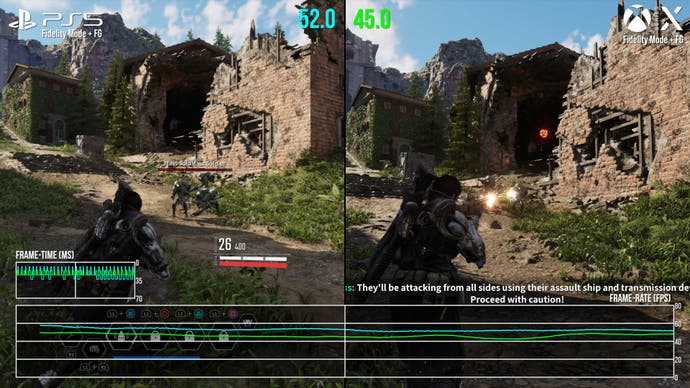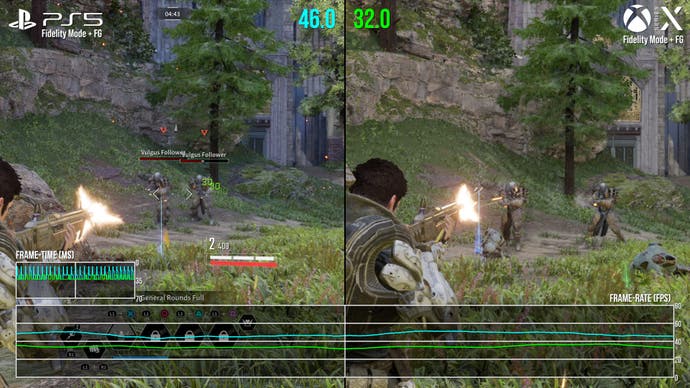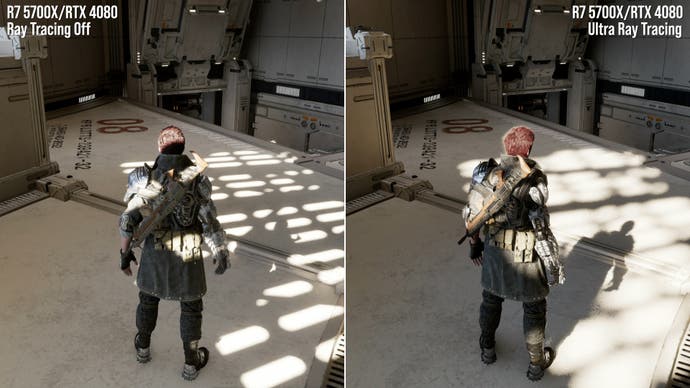This console generation has given us a wealth of PC-style in-game graphics options, with PS5, Series X and even Series S usually offering at least a quality and performance mode. Developer Nexon Games’ latest effort, The First Descendant, goes a step further than most though, with this free-to-play Unreal Engine 5 shooter offering three core modes – but then also FSR 3 frame generation to increase performance on each, and a ray tracing toggle. The result is a lot of permutations to cover here, and the frank truth of the matter is that only a few of these settings are actually worth using.
The First Descendant falls into a similar trap as the 2022 Saints Row Reboot for example – and even the more recent Hogwarts Legacy. In each of those cases it was ‘mode overload’ on PS5, Series X and S, with developers essentially off-handing part of the optimisation work to the end user. Without a definitive, recommended option, the huge range of mode combinations ultimately makes it difficult for end users to know which to select on first boot-up – short of play-testing all of them – and with the potential for distastrous frame-rate performance. So it is true here as well: The First Descendant offers nine possible ways to play on PS5 and Series X, with a 60fps performance mode, 40fps balanced mode (on 120Hz displays) and 30fps fidelity mode – plus those frame generation and ray tracing toggles.
With that in mind, we’ve tested how each mode performs on PS5, Series X and Series S, how successfully frame generation is able to push to a 60fps target, and fundamentally which combination is the best way to play on each platform. To make all of this information easier to parse, we’ve even assembled a few tables below covering every native resolution in each mode. We’ve also investigated the game’s ray tracing implementation on console (sans Series S where the option is removed), which has some key issues.
With regards to ray tracing, let’s nip the issue in the bud right away. On PC, there’s a generous suite of options to tinker with, with the full complement of Nvidia DLSS 3.5 and AMD FSR 3 features plus multiple tiers of ray tracing quality. At best, you can engage RT reflections, RT shadows and RT ambient occlusion via a single drop-down menu – via the ultra setting – but this heightened fidelity comes at an expected cost to performance. In the end, even high-end hardware like the RTX 4080 in our test rig required frame generation for a fluid frame-rate. Also, while the benefits of the ray traced shadows and AO stand out most – with shadow outlines across the main hub area switching to a more realistic, diffused look – it is not essential to this particular playing experience, and the game presents well with the typical rasterised approach.
While the PC version’s RT support demands a form of frame gen technology to run well, the console versions present a conundrum. On PS5 and Series X, you’re forced to choose between either RT or frame generation – you can’t enable both – and the RT mode only functions with the 30 and 40fps modes too. Also frustratingly, the RT mode’s visual impact on console is very limited; it misses the satisfying boost in shadow rendering seen on PC’s top ultra preset, and rather it settle for a minor improvement to ambient occlusion around the character. Worst of all I’ve had multiple software lock-ups with RT enabled on PS5 and Series X (often while accessing the character inventory menu), meaning that at present there’s no good reason to enable RT on console. Presumably future patches will fix this issue, but for now PC is the most dependable avenue for RT support – if your graphics hardware is up to the challenge.
That brings us to the modes that do work on console – and it’s still a long list that spans two tables (below). PS5 and Series X offer an identical setup, with each mode offering a different internal resolution and FPS target. In every case the pixel count is reconstructed with AMD’s FSR 3 to accumulate a 4K image over multiple frames, but you’ll catch glimpses of the true pixel count at the screen’s edges.
| PS5/Series X | Fidelity Mode | Balanced Mode (120Hz) | Performance Mode |
|---|---|---|---|
| FPS Target | 30fps | 40fps | 60fps |
| Resolution | Dynamic 2560×1440 – 3840×2160 | Dynamic 2080×1170 – 3840×2160 | Dynamic 1280×720 – 2560×1440 |
| FPS Target (Frame Gen On) | 90fps (PS5), 60fps (XSX) | 90fps (PS5), 60fps (XSX) | 90fps (PS5), 60fps (XSX) |
| Resolution (Frame Gen On) | Fixed 2240×1260 | Fixed 1920×1080 | Fixed 1494×840 |
To the game’s credit, the 30fps fidelity mode runs remarkably well. I’ve only seen a few single frame drops under 30 in my testing on both PS5 and Series X, with the worst case scenario being one streaming hitch on the first mission – plus, again, single dropped frames during any camera cut in cutscenes. It’s possible that this 30fps fidelity mode’s dynamic resolution goes lower than 1440p as well, but so far it is comfortably operating within that range.
The balanced mode, available only when the game is set to 120Hz output, holds onto a 40fps target well on each console too. Inevitably the dynamic resolution drops lower to balance the GPU load (down to 1170p in this case), but it’s a great compromise between image quality and performance. The one snag with this option is its implementation on Xbox consoles – both Series X and S – where the 40fps cap is unevenly frame paced, leading to a choppy ordering of frames. PS5 on the other hand renders a smooth 40fps line here, making it much easier to recommend in that case.
The performance mode has a different setup entirely. On PS5 and Series X, this mode guns for 60fps, but with a lesser 1440p target that dynamically drops to as low as 720p. Numbers in between are more common (eg 900p) – but curiously the entire image only ever aims to reconstruct back up to a 1440p frame. Even the HUD in this mode presents at 1440p, which is then rescaled to suit a 4K display. The bottom line is image quality takes a hit, and I noticed shadow and post effects like depth of field also take a hit in quality.
| Series S | Fidelity Mode | Balanced Mode (120Hz) | Performance Mode |
|---|---|---|---|
| FPS Target | 30fps | 40fps | 60fps |
| Native Resolution | Dynamic 1280×720 – 2560×1440 | Dynamic 1280×720 – 2560×1440 | Dynamic 960×540 – 1920×1080 |
| FPS Target (Frame Gen On) | 60fps | 60fps | 60fps |
| Native Resolution (Frame Gen On) | Fixed 1494×840 | Fixed 1280×720 | Fixed 1138×640 |
As for its actual performance level, PS5 and Series X do reap the rewards for dropping the resolution bounds, with a relatively stable 60fps in most scenarios. The main outlier seems to be a stretch around the first Kingston area, with big traversal hitches being possible when turning a corner and also single dropped frame when enemy grunts spawn in. It’s frustrating that the 60fps lock isn’t as tight as it could be; it’s not a 100 per cent lock by any means. Likewise, we have frame drops between every camera cut during in-engine cinematics on PS5 and Series X. Overall, even with the semi-frequent drops to 59fps, this still remains the better way to enjoy a shooter so predicated on quick reflexes.
Beyond these basic three modes, AMD’s FSR 3 is supported on console too, where adding frame generation into the mix requires a 120Hz output and pushes every mode to target 60fps. The dynamic resolutions are altered too, with each machine opting for a fixed resolution target in every case (note the tables above). Fixing the values like this is a curious choice but makes sense: it gives the frame gen tech a constant pixel structure to work with, with no deviations to confuse it – and we see a similar approach with Immortals of Aveum’s FSR 3 support on console.
With all three modes stacked up in comparison, it’s worth stressing that visual settings between all three are very close. Depth of field lowers in quality on performance and balanced modes during cinematics, as do shadows on character faces. Above all though, it’s the resolution divide that stands out most – and has the biggest impact on frame-rate.
One major difference between PS5 and Series X however is in their frame rate targets with FSR 3 frame gen enabled right now. On PS5, the technology attempts to run at 90fps, whereas Series X and S are set up to hit 60fps. [Update 26.07.24] A quick clarification that this is true of its latest update as of publishing. However, on previous patches PS5 and Series X/S targeted different frame-rates with frame gen enabled: at one point PS5’s frame gen option also targeted 60fps, and prior to that the frame gen mode even targeted the full 120fps on both PS5 and Series X. As a curious aside, while in-engine gameplay currently caps at 60fps on Xbox, the HUD overlay (ie. the destination marker) updates at 90fps with frame gen regardless – hence this HUD is disabled for our capture in the video for accurate frame detection of gameplay itself.
Focusing on Series X first, bizarrely, frame-rate readings show that its performance mode is the only one capable of getting to 60fps consistently. Even with frame gen in assistance, the fidelity mode too often falls below the 60fps target with frame gen, coming in as low as the mid-30s during cutscenes. It’s impossible to recommend using fidelity mode this way, and it’s a dead end in terms of any practical use-case.
Balanced mode, equally, does not fare much better on Series X when compared to the broken capped 40fps experience with no frame gen enabled. Adding frame gen does at least allow for a rise to 60fps in segments, matching the performance mode’s 60fps line in simpler areas, but cutscenes and explosion-heavy gameplay still drop to the mid-40s or even the high thirties, which doesn’t happen with frame-gen disabled.
Finally, the performance mode with frame gen has few benefits, and in fact, it only appears to invite more issues to the Series X experience. The drops under 60fps are more frequent, perhaps owing to how it runs at fixed 840p with frame gen – higher than the 720p lower bound of its dynamic setup with frame gen disabled. On top of that, performance mode also runs with uneven frame pacing when it hits 60fps (within a 120Hz output from the console), with frame-time spikes above 16.7ms that create an erratic and choppy result. None of this happens when running at the regular 60Hz, with no frame gen involved. To compound the issue, on a 120Hz display, we noticed that VRR doesn’t engage properly on PS5 or Series X, even when forcing the option through PS5’s system menus. It outputs at 60fps throughout at best, and regardless the frame-time reading is more choppy with frame-gen enabled.
Overall then, across all three modes on Series X, The First Descendant runs better with no frame gen option involved – which feels like a wasted opportunity.
Next up, PS5 throws something of a curveball our way with its higher 90fps target allowed by FSR 3 frame gen. All resolution metrics are identical to Series X, but running at 90fps does mean that PS5 outputs 50 per cent more frames per second than the Xbox console in the best case. It’s an odd fit too, slotting 90fps within a 120Hz output feed, and equally, it’s clearly a stretch for the fidelity mode to generate triple the number of frames from a baseline 30fps. On the plus side, mixing the performance mode with frame gen gets us to the 90fps line more often than you’d expect. It’s between 70-90fps most of the time in gameplay, albeit with highly erratic readings on the frame-time graph. As for the balanced and fidelity modes this is clearly too much of a stretch: 30-60fps is the range there, and again, in every mode we found VRR didn’t engage as it should to resolve the erratic frame times. Even at 90fps, frame gen is still not as useful as it should be on Sony’s hardware, and often, disabling frame gen for a more consistent 60fps is a better way to go.
Comparing PS5 versus Series X directly, it’s clear that the PS5 leads in every test too – regardless of the higher frame-rate cap with frame gen involved. Matching gameplay is tricky in this title, but the PS5 reading is typically 10fps or more ahead of Series X in fidelity mode stress tests. I’d be hard pressed to recommend using frame gen with any mode on either console honestly, but for whatever reason the PS5 version is at least able to generate more frames in the end.
Otherwise, visually speaking, the two are a match in every regard: resolution targets, textures, effects quality, post processing settings, it’s all matched. Hopefully the frame generation implementation will improve with more patches, as Nexon already appears keen to make major changes to the game post-launch.


Finally, Series S has the same mode options as PS5 and Series X, but suffers from many of the same issues and runs at significantly lower resolutions. In order to hit 30fps on fidelity mode and 40fps in balanced mode, Series S targets 1440p at best with a 720p lower bound.
As a 30fps capped experience it’s robust overall; you’re getting single dropped frames in gameplay, and more often in cinematics during camera cuts, but it’s stable otherwise. The 40fps balanced mode, on the other hand, is hard to recommend. As with Series X the 40fps cap doesn’t work as it should, and exhibits fluctuations up to 45fps or even 60fps when looking at the sky. Meanwhile, the performance mode drops to a 1080p target with 540p as the lower bound. Even running at this PlayStation Vita-like resolution, the turnout is unfortunately laboured, with 60fps possible for stretches but nosedives into the mid-40s commonplace. Given Series S’ issues with the performance and balanced modes, the 30fps fidelity mode is our recommended pick on this console.
Lastly, Series S does of course offer the same frame gen toggle as Series X and PS5, but with lower fixed resolutions to match its GPU prowess: 640p in performance mode, 720p in balanced mode and 840p in fidelity mode. Most settings are a match for the premium machines, with the exception of shadow quality which is visibly downgraded on all modes. As with PS5 and Series X, frame gen doesn’t improve performance and only introduces extra frame pacing issues at its peak 60fps line – which is a real shame.


Without a doubt, The First Descendant needs more work on console. I’ve had all manner of bugs in my week testing the game: ugly and decimated player animations around the hub area, heavy shadow pop-in, points where a player slips through the geometry to fall endlessly, and lastly, multiple crashes with the RT mode enabled. For the ray tracing mode on PS5 and Series X, the fact that these crashes still persist today makes the option a write-off, pending a patch update. The game’s frame-rate woes tower above these issues though, in that only a select few mode combinations (including the frame gen option) deliver a desirable, smooth result.
On PS5 and Series X, I’d suggest the 60fps performance mode as the ideal way to play today, and on PS5 the standard 40fps balanced mode is also a winner if you have a 120Hz display connected. It’s advisable to avoid the frame gen toggle since it only adds uneven frame pacing at 60fps – or 90fps – on each mode, with no functional VRR to save it. On Series S, the only mode that seems viable is the 30fps fidelity mode. Again, this points to a failure of the frame gen option to fill in the blanks and achieve a perceptual 60fps result, while issues with its standard 40 and 60fps modes linger.
The overwhelming sentiment here is that The First Descendant is generous on settings, but lacks the common sense to set most of them up properly. Too many options lead to poor performance, where a limit to just the ones that truly work would be far better. Looking at the game more broadly, there is a lack of polish all-round that needs addressing, and in particular the stability of the RT mode desperately needs a fix.




